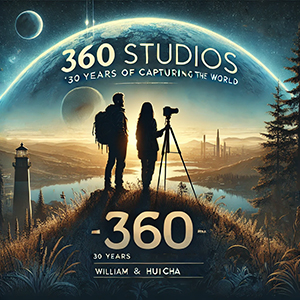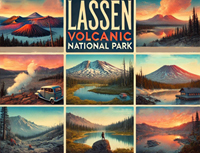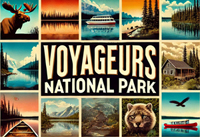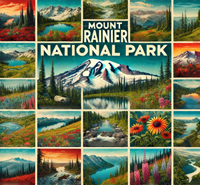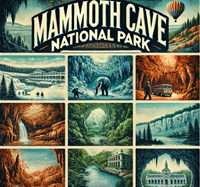

Embark on a journey curated by seasoned explorers William and Hui Cha Stanek, who have spent decades immersing themselves in the diverse landscapes of North America. These itineraries are more than just travel plans - they are thoughtfully crafted adventures designed to help you connect with the natural world, discover hidden gems, and create lasting memories.
National Parks Index | US Itineraries Index | American Roadtrips Index

Bring home a Bugville Critters book and watch as your child's love for reading and learning grows with every page. Hand-painted illustrations bring the heartwarming stories to life. Ask your librarian to add Bugville Critters to the library's digital collection today!
Discover William Stanek's Exclusive Art Collection
Explore and purchase the stunning art featured on this site. Own a piece of William Stanek's unique and captivating artwork today!
(January 28, 2025) Exploring Olympic National Park and Mount St. Helens National Volcanic Monument: Washington's Natural Wonders
Introduction: A Journey Into the Heart of the Pacific Northwest
Something about the Pacific Northwest has always captivated me. Maybe it's the way the mist clings to the towering trees in the early morning, or the way the landscape feels ancient and untouched, as if time moves a little slower here. For Hui Cha and me, the draw of Washington's wilderness has always been irresistible, and there are few places that embody the rugged beauty of this region better than Olympic National Park and Mount St. Helens National Volcanic Monument.
Our journey into these natural wonders began early one summer morning as we drove along Highway 101, the dense forest of the Olympic Peninsula stretching out before us. The air was thick with the scent of pine and cedar, and the sound of our tires on the wet pavement was the only noise in the otherwise silent world around us. As we neared the entrance to Olympic National Park, the trees seemed to close in, forming a canopy that filtered the soft morning light and created an almost ethereal atmosphere.
Olympic National Park is a place of contrasts – a land where rugged coastlines meet lush rainforests, and snow-capped peaks rise above deep, ancient forests. It's a place where you can lose yourself in the wild beauty of nature and find a sense of peace that's hard to come by in our busy, modern world. As we explored the park's diverse landscapes, from the windswept beaches of the Pacific coast to the moss-draped trees of the Hoh Rain Forest, we felt a deep connection to this land – a connection that only grew stronger as we ventured deeper into the park.
A few days later, we found ourselves standing on the edge of a different kind of wilderness – one shaped not by the slow march of time, but by a single, cataclysmic event. Mount St. Helens, with its jagged crater and barren slopes, is a stark reminder of the power of nature and its ability to reshape the world in an instant. The landscape here is raw and unforgiving, but there's a beauty in its starkness, a reminder that life is constantly renewing itself, even in the most unlikely of places.
These two parks, so different in their landscapes yet so similar in the sense of wonder they inspire, have become places of pilgrimage for us – places where we can reconnect with nature and with each other. Join us as we take you on a journey through Olympic National Park and Mount St. Helens National Volcanic Monument, sharing our stories, tips, and insights to help you create your own unforgettable memories in Washington's natural wonders.
Day 1: Exploring the Diverse Ecosystems of Olympic National Park
Morning: Sunrise at Hurricane Ridge
Overview
Start your day high in the mountains at Hurricane Ridge, one of Olympic National Park's most iconic locations. At an elevation of 5,242 feet, Hurricane Ridge offers panoramic views of the Olympic Mountains, with the peaks often bathed in the soft light of dawn. On a clear day, you can see all the way to Vancouver Island in Canada.
Tips from William
"Arrive at the Hurricane Ridge parking lot by 5:30 AM to catch the sunrise. The light at this time of day is perfect for photography, especially with the mountains as a backdrop. Use a wide-angle lens to capture the vastness of the scene, and bring a tripod to steady your camera for long exposures as the light begins to change."
Insights from Hui Cha
"Even in the summer, mornings at Hurricane Ridge can be cold and windy, so dress in layers and bring a warm drink. I always like to find a quiet spot away from the crowds to watch the sunrise – it's a peaceful way to start the day and connect with the beauty of the mountains."
How to Access Hurricane Ridge
Directions:
- From Port Angeles, take Hurricane Ridge Road (Olympic Highway) south for 17 miles to the Hurricane Ridge Visitor Center.
- The road is winding and gains significant elevation, so drive carefully, especially in the early morning hours.
Trail Details:
- Sunrise Location: Hurricane Ridge Visitor Center
- Trail Length: Various short trails begin from the visitor center; Sunrise Point is a short walk away.
- Elevation Gain: Minimal (depending on which trail you choose)
- Difficulty: Easy
Photography Tips: For a stunning sunrise shot, set up your tripod on the ridge near the visitor center. Capture the first light as it hits the peaks, creating a golden glow on the snow-capped mountains. A telephoto lens can help you zoom in on specific details, such as the ridges and valleys, while a wide-angle lens is ideal for capturing the full scope of the landscape.
Alternative Activity: If you prefer a more accessible sunrise location, consider watching the sunrise from the parking lot at the visitor center. The views are still spectacular, and there are several benches where you can sit and enjoy the scene without the need for a strenuous hike.
Mid-Morning: Hiking the Hurricane Hill Trail
Overview
After taking in the sunrise, continue your morning with a hike along the Hurricane Hill Trail. This trail offers sweeping views of the surrounding mountains and valleys, and on clear days, you can see all the way to the Strait of Juan de Fuca. The trail is paved and well-maintained, making it accessible for most hikers.
Tips from William
"The Hurricane Hill Trail is a 3.2-mile round-trip hike with a moderate elevation gain. Start early to avoid the crowds and bring plenty of water, as the trail is exposed to the sun for much of the hike. A polarizing filter can help reduce glare and enhance the colors of the sky and landscape."
Insights from Hui Cha
"This hike is one of my favorites in the park because of the incredible views it offers. The trail is well-graded and relatively easy, making it a great option for families and hikers of all skill levels. Take your time and enjoy the scenery – there's no need to rush."
How to Access Hurricane Hill Trail
Directions:
- The trailhead is located at the end of the Hurricane Ridge Road, near the visitor center.
Trail Details:
- Trail Length: 3.2 miles round-trip
- Elevation Gain: 650 feet
- Difficulty: Moderate
Photography Tips: As you hike along the trail, keep your camera ready to capture the changing views. Use a wide-angle lens to photograph the expansive vistas, and switch to a telephoto lens to zoom in on the details of the distant peaks. For a more creative shot, try framing the mountains with the wildflowers that line the trail in the summer months.
Alternative Activity: If the Hurricane Hill Trail is too challenging, consider exploring the shorter Cirque Rim Trail, which is 1.2 miles round-trip with minimal elevation gain. This trail offers beautiful views of the surrounding mountains and is an excellent option for those seeking a less strenuous hike.
Afternoon: Exploring the Hoh Rain Forest
Overview
In the afternoon, descend from the mountains and enter the lush, otherworldly landscape of the Hoh Rain Forest. This temperate rainforest is one of the most unique environments in the United States, with towering trees draped in moss, ferns covering the forest floor, and a sense of ancient mystery that pervades the air.
Tips from William
"The Hoh Rain Forest is a photographer's paradise, but the dense foliage and low light can be challenging. Bring a tripod to keep your camera steady for long exposures, and use a wide-angle lens to capture the towering trees and the depth of the forest. A polarizing filter can help enhance the greens and reduce reflections on wet surfaces."
Insights from Hui Cha
"The Hoh Rain Forest is a place to slow down and take in the details. The sounds of the forest – the rustling of leaves, the trickle of streams, the calls of birds – create a soothing atmosphere that makes you feel completely immersed in nature. I love taking the Hall of Mosses Trail, which is a short, easy loop that showcases some of the most impressive trees in the forest."
How to Access the Hoh Rain Forest
Directions:
- From Port Angeles, take US-101 West for about 88 miles to the Hoh Rain Forest Road (Olympic Highway).
- Turn left onto Hoh Rain Forest Road and continue for 18 miles to the Hoh Rain Forest Visitor Center.
Trail Details:
- Hall of Mosses Trail: 0.8 miles round-trip, easy, minimal elevation gain.
- Spruce Nature Trail: 1.2 miles round-trip, easy, minimal elevation gain.
Photography Tips: For the best shots, visit the forest on a cloudy day, when the light is diffused and the greens are more vibrant. Use a slow shutter speed to capture the movement of the streams and the swaying of the ferns. Don't be afraid to get close to the details – macro shots of moss, leaves, and tree bark can reveal the intricate beauty of the forest.
Alternative Activity: If you prefer a longer hike, consider exploring the Hoh River Trail, which extends for 17.3 miles to Glacier Meadows. You don't have to hike the entire trail – just a few miles in will take you deeper into the heart of the rainforest, offering even more opportunities to experience the lush landscape.
Evening: Sunset at Rialto Beach
Overview
End your day with a visit to Rialto Beach, located on the western edge of the park along the Pacific Ocean. This beach is known for its dramatic sea stacks, tide pools, and stunning sunsets. The sound of the waves crashing against the shore, combined with the vibrant colors of the sunset, creates a truly unforgettable experience.
Tips from William
"Rialto Beach is one of the best places in the park to capture a sunset. Arrive at least an hour before sunset to explore the tide pools and set up your camera. A wide-angle lens is perfect for capturing the sea stacks and the sunset, but a telephoto lens can also be useful for zooming in on the details of the waves and the rocks."
Insights from Hui Cha
"Rialto Beach has a wild, untamed beauty that I absolutely love. The sea stacks rising out of the water, the driftwood scattered along the shore, and the sound of the ocean all combine to create a sense of peaceful isolation. Bring a blanket and a warm drink, and take some time to simply sit and watch the sun sink into the ocean."
How to Access Rialto Beach
Directions:
- From the Hoh Rain Forest, return to US-101 and head north to Forks.
- From Forks, take WA-110 West for 8 miles, then turn right onto Mora Road and continue for 5 miles to the Rialto Beach parking area.
Beach Details:
- Trail Length: The beach itself is accessible by a short walk from the parking area. The Hole-in-the-Wall hike is 3.3 miles round-trip.
- Difficulty: Easy (moderate if hiking to Hole-in-the-Wall)
Photography Tips: For a dramatic sunset shot, position yourself near one of the sea stacks to use it as a silhouette against the setting sun. Use a tripod to stabilize your camera for long exposures, which will smooth out the water and create a dreamy effect. Don't forget to experiment with different angles and compositions to capture the essence of this wild coastline.
Alternative Activity: If you prefer a shorter walk, consider visiting the nearby First Beach in La Push, which offers similar views and is easily accessible from the parking area. The beach is less crowded and provides a more intimate setting for watching the sunset.
Conclusion: Reflections on the Day
As the last light of day faded from the sky and the stars began to emerge, Hui Cha and I sat quietly on the driftwood at Rialto Beach, reflecting on the incredible journey we had just experienced. From the towering peaks of Hurricane Ridge to the lush, ancient forests of the Hoh Rain Forest, and finally, the wild, windswept shores of Rialto Beach, each moment had been a reminder of the incredible diversity and beauty of Olympic National Park.
These are the kinds of experiences that stay with you long after the trip is over – the quiet moments of reflection, the awe-inspiring views, and the sense of peace that comes from being immersed in nature. As we packed up our gear and prepared to head back to our campsite, I couldn't help but feel a deep sense of gratitude for the day's adventures and for the time spent in this remarkable park.
Our journey through Washington's natural wonders was far from over. Tomorrow would take us to the stark, dramatic landscapes of Mount St. Helens, where the power of nature is on full display in a land that has been forever changed by a single, cataclysmic event. But for now, we were content to sit beneath the stars, listening to the sound of the waves and feeling the peace that only comes from being in the heart of the Pacific Northwest.
Day 2: The Stark Beauty of Mount St. Helens National Volcanic Monument
Morning: Sunrise at Johnston Ridge Observatory
Overview
Start your day at Mount St. Helens National Volcanic Monument with a sunrise at Johnston Ridge Observatory. Located just five miles from the crater, this viewpoint offers a front-row seat to the raw power of the volcano, with the crater and surrounding landscape bathed in the soft light of dawn.
Tips from William
"Arrive at Johnston Ridge by 5:30 AM to set up your camera and find the best spot. Use a telephoto lens to capture the details of the crater and the surrounding blast zone, and don't forget a wide-angle lens to capture the full scope of the landscape. A graduated neutral density filter can help balance the exposure between the bright sky and the darker land."
Insights from Hui Cha
"Mornings at Mount St. Helens can be cold, even in summer, so dress warmly and bring a hot drink. The stillness of the morning, combined with the stark beauty of the landscape, creates a sense of awe and reverence. I love taking a few moments to reflect on the power of nature and the resilience of life in this ever-changing environment."
How to Access Johnston Ridge Observatory
Directions:
- From Castle Rock, take WA-504 East (Spirit Lake Highway) for approximately 50 miles to the Johnston Ridge Observatory.
Overlook Details:
- Location: Johnston Ridge Observatory, at the end of WA-504
- Elevation Gain: None (observatory is accessible by car)
- Difficulty: Easy
Photography Tips: For a stunning sunrise shot, set up your tripod near the observatory and capture the first light as it hits the crater and the surrounding landscape. Use a small aperture (f/16 or smaller) to keep the entire scene in focus, and experiment with different shutter speeds to capture the changing light. If the conditions are right, you may even catch a glimpse of the steam rising from the crater, adding an extra element to your photos.
Alternative Activity: If the early start at Johnston Ridge is too demanding, consider watching the sunrise from the Loowit Viewpoint, located just a few miles down the road. The views are still spectacular, and the parking area is less crowded, making it a great alternative for a more relaxed morning.
Mid-Morning: Exploring the Eruption Trail
Overview
After taking in the sunrise, continue your morning with a walk along the Eruption Trail, a short interpretive trail that offers incredible views of the crater, the blast zone, and the surrounding landscape. The trail is paved and includes several interpretive signs that provide insight into the events of the 1980 eruption and the ongoing recovery of the area.
Tips from William
"The Eruption Trail is an easy 1-mile round-trip walk, but the views are anything but ordinary. Bring a wide-angle lens to capture the vastness of the landscape, and a telephoto lens to zoom in on the details of the crater and the surrounding blast zone. A polarizing filter can help reduce glare and enhance the colors of the sky and landscape."
Insights from Hui Cha
"This trail offers a fascinating glimpse into the power of Mount St. Helens and the resilience of the landscape. The interpretive signs along the way provide a deeper understanding of the events that took place here and the ongoing process of recovery. Take your time and read the signs – it's a powerful reminder of nature's ability to both destroy and renew."
How to Access the Eruption Trail
Directions:
- The trailhead is located at the Johnston Ridge Observatory parking area.
Trail Details:
- Trail Length: 1 mile round-trip
- Elevation Gain: Minimal
- Difficulty: Easy
Photography Tips: As you walk along the trail, keep your camera ready to capture the changing views. Use a wide-angle lens to photograph the expansive landscape, and switch to a telephoto lens to zoom in on the details of the crater and the surrounding terrain. For a more creative shot, try framing the crater with the wildflowers that have begun to reclaim the land.
Alternative Activity: If you're looking for a more challenging hike, consider exploring the Harry's Ridge Trail, a 8-mile round-trip hike that offers stunning views of the crater, Spirit Lake, and Mount Adams in the distance. The trail is more strenuous but well worth the effort for those seeking a deeper experience in this incredible landscape.
Afternoon: Hiking the Hummocks Trail
Overview
In the afternoon, explore the Hummocks Trail, a unique 2.3-mile loop that takes you through the hummocks – mounds of earth and rock deposited by the landslide during the 1980 eruption. This trail offers a fascinating look at the aftermath of the eruption, with a landscape that is still in the process of recovery.
Tips from William
"The Hummocks Trail is a relatively easy hike, but the terrain can be uneven in places, so wear sturdy shoes. Bring a wide-angle lens to capture the unique landscape, and a macro lens to photograph the wildflowers and other small details that have begun to reclaim the land. The trail offers several viewpoints where you can see the hummocks in the foreground with Mount St. Helens in the distance."
Insights from Hui Cha
"This trail is a perfect example of the resilience of nature. The landscape here is still recovering from the eruption, but life is slowly returning, and the hummocks are now covered with grasses, wildflowers, and young trees. It's a beautiful reminder that even in the face of destruction, life finds a way."
How to Access the Hummocks Trail
Directions:
- From the Johnston Ridge Observatory, return to WA-504 and drive west for approximately 10 miles to the Hummocks Trail parking area.
Trail Details:
- Trail Length: 2.3 miles round-trip
- Elevation Gain: Minimal
- Difficulty: Easy
Photography Tips: As you hike along the trail, look for opportunities to capture the contrast between the barren hummocks and the vibrant life that is slowly returning. Use a wide-angle lens to photograph the landscape, and switch to a macro lens to capture the intricate details of the wildflowers and grasses. For a more dramatic shot, position yourself at one of the viewpoints and use a telephoto lens to capture Mount St. Helens in the distance.
Alternative Activity: If you prefer a shorter walk, consider exploring the nearby Coldwater Lake Recreation Area, where you can take a leisurely stroll along the lakeshore and enjoy the stunning views of Mount St. Helens reflected in the water. The Coldwater Lake Trail is 0.8 miles round-trip and is an excellent option for those seeking a more relaxed afternoon.
Evening: Sunset at Windy Ridge
Overview
End your day with a visit to Windy Ridge, one of the most dramatic viewpoints in the park. From here, you can see the crater, Spirit Lake, and the surrounding blast zone, all bathed in the warm light of the setting sun. The road to Windy Ridge is steep and winding, but the views at the top are well worth the effort.
Tips from William
"Windy Ridge is one of the best places in the park to capture a sunset. Arrive at least an hour before sunset to set up your camera and find the best spot. A wide-angle lens is perfect for capturing the expansive views, but a telephoto lens can also be useful for zooming in on the details of the crater and Spirit Lake. A graduated neutral density filter can help balance the exposure between the bright sky and the darker land."
Insights from Hui Cha
"Windy Ridge is a place that takes your breath away – not just because of the steep drive to get here, but because of the incredible views. The sunset here is absolutely magical, with the light turning the landscape into a sea of gold and orange. Bring a blanket and a warm drink, and take some time to simply sit and watch the sun dip below the horizon."
How to Access Windy Ridge
Directions:
- From the Johnston Ridge Observatory, return to WA-504 and drive west for approximately 35 miles to Forest Road 99.
- Follow Forest Road 99 for about 16 miles to the Windy Ridge parking area.
Overlook Details:
- Location: End of Forest Road 99
- Elevation Gain: None (overlook is accessible by car)
- Difficulty: Easy
Photography Tips: For a stunning sunset shot, set up your tripod near the edge of the overlook and capture the last light as it hits the crater and Spirit Lake. Use a small aperture (f/16 or smaller) to keep the entire scene in focus, and experiment with different shutter speeds to capture the changing light. If the conditions are right, consider staying after sunset to photograph the stars as they appear.
Alternative Activity: If the drive to Windy Ridge is too long, consider watching the sunset from the nearby Smith Creek Overlook, located just a few miles down the road. The views are still spectacular, and the parking area is less crowded, making it a great alternative for a more relaxed evening.
Conclusion: A Personal Reflection
As the last rays of sunlight faded from the sky and the stars began to emerge, Hui Cha and I stood in awe at Windy Ridge, reflecting on the incredible journey we had just experienced. From the lush, ancient forests of Olympic National Park to the stark, dramatic landscapes of Mount St. Helens, each moment had been a reminder of the power and beauty of nature.
These parks are more than just places to visit – they are places to connect with the natural world, to find peace and inspiration, and to create memories that will last a lifetime. As we packed up our gear and prepared to leave, I felt a deep sense of gratitude for the time we had spent in these wild, untamed places. They had not only shown us the beauty of the land but had also brought us closer to each other and to the world around us.
Our journey through Washington's natural wonders had come to an end, but the experiences we had shared would stay with us forever. And as we drove away from the mountain, I knew that we would return, drawn back by the promise of new adventures and the chance to explore even deeper into the heart of the Pacific Northwest.

Step into a world of timeless beauty with our premium, oversized hardcover book - crafted for discerning collectors and anyone who values the power of art. Perfect for your coffee table, it's more than just a book; it's a conversation starter, a window into over 30 years of William's visionary photography.
Your Support Matters
Purchasing artwork from William Stanek's collection not only brings beauty into your life but also helps us continue to share. Thank you for supporting our creative journey!

Support The Lights of Paris by Robert Stanek, William Stanek's pen name! Through vivid historical detail and deeply moving character stories, Robert takes readers on an unforgettable journey through one of history’s most transformative times.

